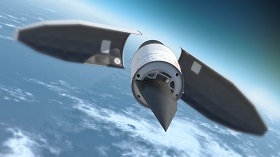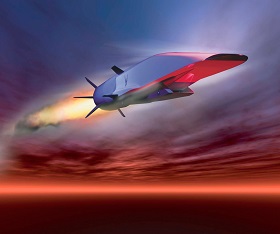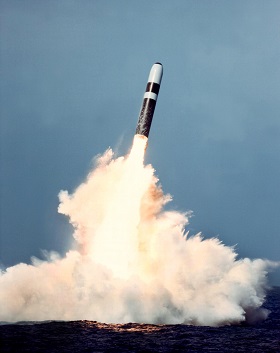Should We Be Afraid of Prompt Global Strike?
Lockheed's hypersonic missile concept
(votes: 1, rating: 5) |
(1 vote) |
PhD in Political Science, RIAC expert
American efforts to develop Prompt Global Strike systems have caught the attention of Russian leaders and experts for some time. Amidst deteriorating Russia-US relations, these efforts are perceived rather warily by the Russian side and often treated as a threat to the strategic stability and national security of Russia. To find out if these concerns are justified, we must look closely into the matter.
American efforts to develop Prompt Global Strike systems have caught the attention of Russian leaders and experts for some time. Amidst deteriorating Russia-US relations, these efforts are perceived rather warily by the Russian side and often treated as a threat to the strategic stability and national security of Russia. To find out if these concerns are justified, we must look closely into the matter.
The emergence of the concept
The US military idea of Prompt Global Strike (PGS) implies the ability to deliver a precision strike anywhere in the world within one hour. This involves deploying intercontinental ballistic missiles (ICBMs) in missile silos on US territory or ships/submarines, intermediate-range ballistic missiles or cruise missiles on ships/submarines in forward areas. The PGS concept focuses on reducing dependence on overseas bases and nuclear weapons for strategic deterrence and power projection. Furthermore, ballistic missiles and hypersonic glide vehicles ensure superiority over existing shock weapons (aircraft and various cruise missiles) through their ability to overcome the advanced anti-aircraft/anti-missile defense systems of the enemy. The PGS system is designed to strike the most significant fixed site and mobile targets of the enemy, including well-protected command posts, silo and mobile launchers of ballistic missiles, etc.
Works on PGS are conducted in two main areas, namely the development of ballistic and cruise missiles with precision warheads and hypersonic glide vehicles delivered by the above-mentioned missiles. The development of the first relatively simple and cheap area faces serious opposition from Congress, which fears that such weapons could trigger nuclear war. The development of the second area faces significant technological risks, since it is difficult to say whether they can be overcome fairly quickly.
Next, we consider the main programs of the PGS concept, as well as their development and prospects.
Marine component
The US Navy began to develop non-nuclear warheads for the Trident submarine-launched ballistic missile (SLBM) back in the 1990s. The research, in particular, resulted in the understanding that firing a well-protected target with a non-nuclear warhead would require a significant increase in the accuracy of the ballistic missile.
For fiscal years [1] 2003 and 2004, the Navy requested budget funding to begin a three-year Enhanced Effectiveness (E2) Reentry Body program to improve the accuracy of existing warheads Mik4 [2]. However, Congress rejected the Navy’s funding request, but Lockheed Martin conducted the research at its own expense, including successful tests in 2002 and 2005.
Then the Navy planned to launch a Conventional Trident Modification (CTM) program to equip some Trident SLBMs with non-nuclear warheads, created on the basis of Lockheed Martin high-precision warheads [3]. For fiscal years 2007 and 2008, the Navy requested funding for the CTM (initially $503 million for the five-year program in 2007-2010 fiscal years and then $175.4 million for the year in the request for FY2008). The Navy planned to equip 12 of 14 SSBNs Ohio with two conventional Trident SLBMs carrying four warheads each [4].
Congress again rejected the Navy’s funding request. The main reason for Congress’s failure to fund the Navy’s PGS programs is lawmakers’ concern that a conventional ballistic missile launch might be mistaken by other powers, such as Russia, for a nuclear one and trigger a retaliatory strike. For FY2007, only $25 million was allocated for R&D, for all PGS systems, needs’ analysis and search for alternatives.
In an attempt to bypass Congressional restrictions, the Navy requested $3 million for FY2009 to test “Life Extension Test Bed-2” (LETB-2) warhead carried by Trident SLBM, which, according to representatives of the Navy, could fit any ballistic missile, but essentially remained a modernized Lockheed Martin high-precision warhead. The Navy also requested $40 million for MLRB warheads for IRBMs for submarines. In addition, the Pentagon announced plans to spend $6 million and $30 million on LETB-2 and MLRB, respectively, out of the $100 million that had been allocated to it for FY2008 within the framework of restructuring the PGS programs (see next section of the article). However, the Congress refused to fund the LETB-2 and MLRB projects.
The US military idea of Prompt Global Strike (PGS) implies the ability to deliver a precision strike anywhere in the world within one hour.
At the same time, the Navy considered the possibility of deploying IRBMs, including non-nuclear ones with a range of about 2000-3000 km, on Ohio SSBNs. Each SSBN missile tube could accommodate 2-3 IRBMs. For fiscal years 2005-2007, the Congress allotted $18.5 million in total for the program to create IRBMs for submarines. In fiscal years 2008 and 2009, the Department of Defense expected to receive $260 million, but the funding program for submarine IRBMs was denied. Thus, the development of PGS marine component was actually ended by Congress, and the money for it was not allocated.
Pentagon’s interest in equipping submarines with PGS conventional weapons revived in 2012. The matter at issue was the possibility of deploying SLCMs or hypersonic glide vehicles on Virginia-class submarines. These missiles, unlike conventional SLBMs are not installed on the SSBN and fly a flat trajectory, which should allow an avoidance of the risk of mistaking it for a nuclear missile. The Navy plans to test the PGS midrange system on submarines in 2015-2016.
The number of missiles that the submarines can carry is unknown, but it is worth remembering that Virginia-class submarines (starting from the eleventh boat) are equipped with two universal payload tubes that are able to carry six Tomahawk cruise missiles apiece, and starting from the twenty-ninth boat another four payload tubes can be added to them, capable of carrying 7 Tomahawk SLCMs each. The budget for FY2014 reflected a shift in the focus of PGS development from intercontinental systems to midrange systems. This testifies to the enhanced prospects of the program to equip Virginia-class submarines with PGS intermediate-range missiles.
The Defence Advanced Research Projects Agency (DARPA) carried out another marine project. Called ArcLight, its program was intended to design, build and test a boost/glide vehicle with a range of about 3700 km, to be launched from a MK 41 Vertical Launch System compatible booster stack or submarine rocket launcher. The missile consisted of a rocket booster based on the SM-3 intercept missile integrated with a glide vehicle that could carry a 100-200 pound payload. In fiscal years 2010-2011, the Arclight was allocated $ 7 million, but after that the program was closed.
Air and ground components

An artist's illustration of DARPA's Hypersonic
Technology Vehicle 2 (HTV-2) travelling at
13,000 mph, or Mach 20, during its Aug. 11,
2011 test flight
In 2003, the Air Force and DARPA launched an R&D initiative to create land-based ICBMs with hypersonic glide vehicle CAV (FALCON program). To save time and money, it was suggested to use re-equipped Minuteman II and Peacekeeper (MX) ICBMs that were removed from combat duty as CAV vehicles [5]. Although the Pentagon had requested only $28.5 million for funding the project, the Congress allocated $38.5 million for fiscal 2004-2005. In contrast to the Navy’s CTM program, Congress did allocate money on the Common Aero Vehicle (CAV) project, but still expressed fears that a launch of ICBMs with CAV could be falsely interpreted as a launch of a nuclear ICBM. Congressional concerns have led to the fact that the Department of Defense was allowed to use the allocated funds just for research in the field of hypersonic technologies only, while designing, testing and integrating CAV with a warhead or ballistic missile were forbidden.
In fiscal years 2006-2007, the Congress allocated additional $60.5 million for the CAV project. Another $12 million was allocated for the CBM program that provided the possibility for using Minuteman ICBM as a provisional carrier within the PGS framework.
In FY2008, the Pentagon requested $208 million for the CAV and other PGS projects (not counting a request for CTM funding). The Congress confined all PGS expenditures to $100 million and, as mentioned above, refused to fund the CTM program at all. The naval CTM program was replaced by the Air Force CSM project that provided for the use of Peacekeeper-based ballistic missile and detachable hypersonic glide vehicle and was less risky in terms of provoking a nuclear war.
So far it is difficult to assess the impact of the PGS on the strategic stability, i.e. the correlation of US and Russia’s strategic forces that offers no incentive for the first strike.
Air Force and DARPA HTV-2 was offered as the main candidate for the role of a hypersonic glide vehicle, and a U.S. Army Advanced Hypersonic Weapon (AHW) project was launched as a fallback program. In FY2009 the Congress allocated a total of $74.6 million for all PGS programs, at the same time, obliging the military to spend at least 25 per cent of the funds on the Army’s AHV program.
For FY2010, the military requested, and the Congress appropriated, $167 million for the PGS, including $91.5 for HTV and $47 million for the AHV. HTV-2 and Minotaur IV ballistic missile integration work began. PGS expenditures in FY2011 maintained the level of the previous year, since the budgeting procedure was replaced by the so-called “continuing resolution”.
The HTV-2 project whose total funding in fiscal years 2008-2011 amounted to $324 million was considered the most promising program. But the tests on April 22, 2010 and August 10, 2011 ended in failure. After that HTV-2 was no longer regarded as the leading project, and funding the program steadily declined. In contrast, the Army’s AHW that had received a much lower share of funding carried out a successful flight test on November 17, 2011, which encouraged increased financing of the program.
The symmetrical response to the PGS will place a heavy burden on the Russian economy, while the search for an asymmetric response appears to be quite a challenge as well.
The PGS budget for FY2012 caused a lengthy debate in Congress and was eventually reduced from $205 million (Pentagon’s request) to $180 million (allocated by Congress). At the same time the successfully tested AHV, in contrast to HTV-2, was protected from cuts. The budget for the FY2013 also led to a lively discussion. The Pentagon asked only $110 million for the PGS programs, while Congress was ready to allocate $200 million, due to an increase in funding of the second AHV flight test. However, the sequestration of military spending resulted in an allocation of $176.5 million for the PGS programs in FY2013, including $148 million for the AHV and only $23 million for the HTV-2. The Army’s program eventually became the undisputed leader. But the second AHW flight test failed on August 25, 2014.
Despite the recent setback, the Pentagon is optimistic about the AHW program and plans to allocate $667.5 million to it in FY2016-2019.
A hypersonic cruise missile with X-51 WaveRider ramjet engine, developed by Boeing, is worth noting too. In 2010-2014, the missile had four flight tests. Recent tests in May 2013 (the missile was launched from a B-52 strategic bomber) proved to be successful. If the program develops successfully, it could provide the US military with hypersonic midrange air-launched cruise missiles.
How real is the threat?

Alexander Saveliev, James Acton:
Strategic Offensive Arms in Non-Nuclear
Configuration: Another Irritant for Russia–
U.S.Relations
Both Russian officials and national experts express their concerns over the US Prompt Global Strike efforts. So far it is difficult to assess the impact of the PGS on the strategic stability, i.e. the correlation of US and Russia’s strategic forces that offers no incentive for the first strike. On the one hand, passing into service of the United States a limited number of PGS systems has no substantial effect on the strategic stability, due to the insignificance of such systems against the backdrop of Russia’s strategic nuclear forces (SNF). On the other hand, the PGS systems are fraught with a number of significant threats to strategic stability and international security.
Firstly, it is not without reason that the American lawmakers have voiced concern that a non-nuclear ballistic missile launch against Russia, China or a third party may be regarded by Russia or China as the beginning of a nuclear attack from the US and provoke a nuclear war. The one-hour requirement for a strike to be delivered severely limits the opportunities for consultations between Washington and Beijing or Moscow, and the use of a hypersonic glide vehicle does not allow a clear definition of the target of the launch and to make sure that the launch is directed against the targets of a third party.
Secondly, a high-precision ballistic missile capable of breaking through national defenses and hitting a highly protected and/or mobile target would deprive a country of its political leadership and deny it the opportunity to make a quick and adequate decision about retaliation.
Thirdly, the creation of relatively cheap weapons systems that are superior in quality to the existing ones (e.g. Tomahawk SLCM) in terms of speed, accuracy, range, and the possibility of hitting mobile and highly protected targets, as well as their mass production, would deliver a significant blow to the system of strategic stability. Indeed, if such systems are deployed, they could be used against Russia’s strategic nuclear forces, which will lead to either the destruction of the Russian nuclear shield, or, more likely, Russia’s immediate retaliatory or subsequent counter nuclear strike. The first option is unacceptable at least for the Russian nation and the second is disastrous for the entire planet. This appears to be particularly relevant in the context of American efforts to develop missile defense systems and long-range strike drones.
The very necessity and feasibility of making substantial expenditures and running military-political risks for the sake of delivering a conventional strike at a longer range within one hour is brought into question, since there are many other tools to launch conventional precision strikes, even if they require much more time.
The symmetrical response to the PGS will place a heavy burden on the Russian economy, while the search for an asymmetric response appears to be quite a challenge as well. The easiest option available is to strengthen and develop early warning systems and strategic nuclear forces that would guarantee a retaliatory strike, irrespective of the entailed financial expenditures, which reduces the nuclear threshold and is fraught with the risk of slipping into a nuclear war.
There is an ongoing debate among the American expert community, lawmakers and the military about the feasibility of deploying the PGS systems. Its supporters emphasize the expansion of the tools available to the President of the United States, increased opportunities for global power projection and the ability to use non-nuclear strategic systems in certain scenarios, instead of the SNF that will supposedly raise the nuclear threshold. They also highlight a wide range of measures that would “set Moscow and Beijing at ease”, namely consultations, inspections, the deployment of PGS systems in areas remote from those of the US strategic nuclear forces deployment (for example, Vandenberg Air Force Base in California or Cape Canaveral, Florida), and the use of systems with trajectories other than those of nuclear ballistic missiles. In the end, Russia, the United States and other countries have for decades carried out numerous launches of ballistic missiles for different purposes, including many tests in the interests of strategic nuclear forces.
PGS opponents indicate that all these measures cannot completely dispel Beijing’s and Moscow’s fears, and eliminate the risk of misunderstandings with catastrophic consequences if the PGS systems are put into action. In addition, the proposed measures of confidence in the case of deploying PGS systems impose a number of restrictions on the United States, ranging from allowing foreign inspections to including conventional ballistic missiles in the country’s strategic nuclear forces. Furthermore, the very necessity and feasibility of making substantial expenditures and running military-political risks for the sake of delivering a conventional strike at a longer range within one hour is brought into question, since there are many other tools to launch conventional precision strikes, even if they require much more time. Finally, the sequestration of military spending and technological problems significantly complicate the realization of PGS projects.
Thus, even the limited deployment of PGS systems is rather risky, and their mass deployment will put the mankind back to the early 1980s, when the world lived in constant expectation of an apocalyptic conflict between the United States and the Soviet Union. It is hoped that the PGS opponents in the United States, financial and technological constraints, the efforts of Chinese and Russian diplomats, as well as “asymmetric response” of the military will help to avoid such a negative scenario. PGS development emphasizes the relevance of including the issue of conventional precision weapons on the agenda of the Russian-American talks on strategic stability.
1. The fiscal year begins on October 1 of the previous calendar year and ends on September 30 of the current calendar year.
2. Existing inertial measurement units were to be supplemented by a GPS guidance system and equipment for maneuvering in the guided flight area. This was to reduce the circular error probable (CEP) to 5-10 meters. The Navy planned to complete a three-year program with flight tests.
3. It was expected that if the program started in 2008, the system could become fully operational by the end of 2012.
4. According to some reports, only 8 of 96 SLBMs could be permanently put on combat duty in the oceans. It was supposed to have two types of warheads: one for hitting well fortified facilities and the other, carrying tungsten destructive elements (MLRB), for hitting surface targets in the area of 270 square meters. Installing MLRB warheads would reduce the range of Trident, transferring it to intermediate-range ballistic missile category.
5. Re-equipped Minuteman II was named Minotaur II, and MX – Minotaur III/IV.
(votes: 1, rating: 5) |
(1 vote) |





